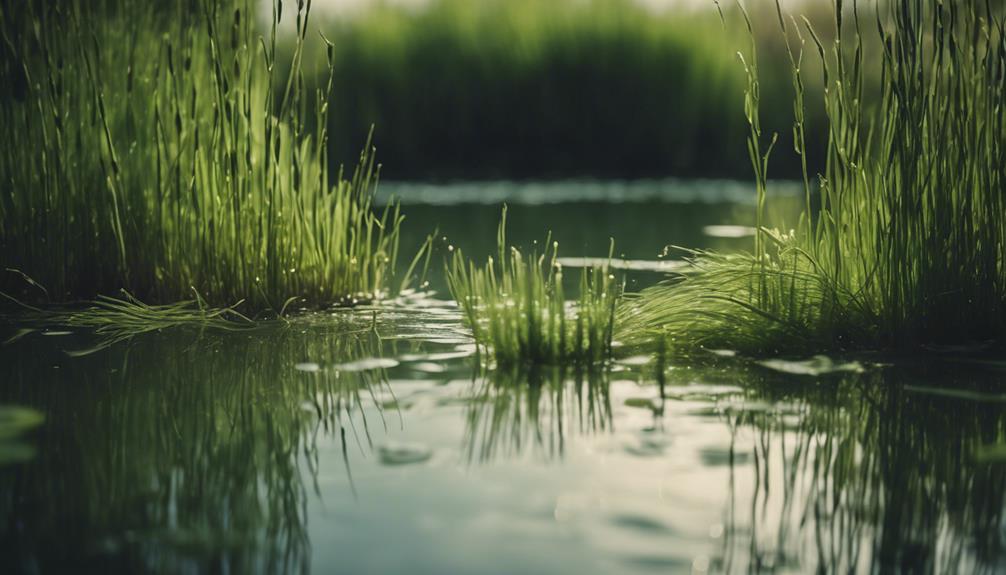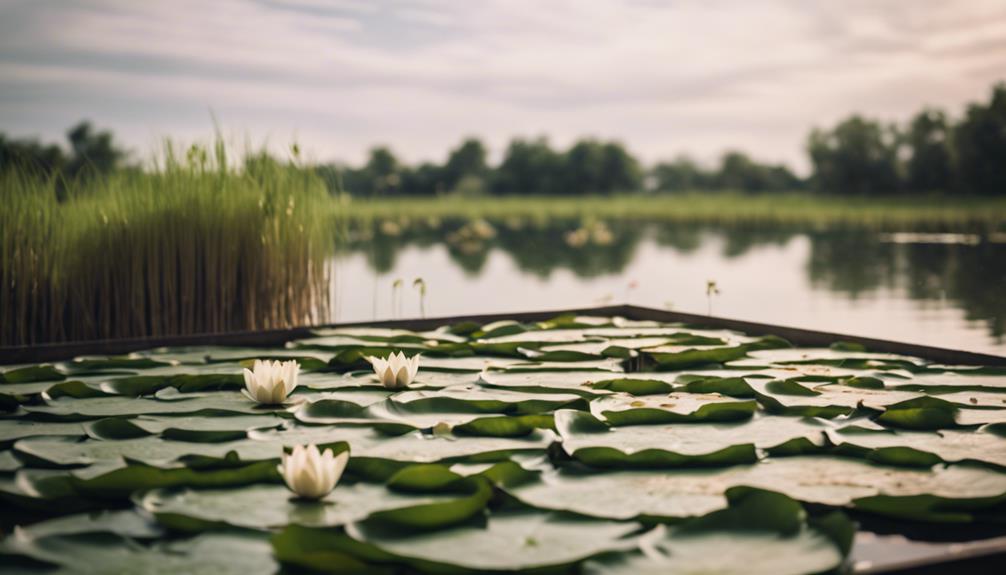You can control algae growth naturally by introducing beneficial bacteria to break down organic matter, manipulating water temperature, pH levels, and light intensity, and utilizing algae-grazing organisms like zooplankton or fish. Combining these methods creates a self-sustaining ecosystem where algae growth is limited. You can also limit excess nutrients by avoiding fertilizers, establishing protective vegetative buffers, and implementing nutrient remediation solutions. Additionally, aerating your pond, using aquatic plants, and introducing beneficial microorganisms can help. By understanding these natural methods, you'll be well on your way to creating a balanced ecosystem where algae growth is under control, and exploring further will reveal even more effective strategies.
Table of Contents
Key Takeaways
- Introduce beneficial bacteria to break down organic matter and reduce algae's food sources, creating a self-sustaining ecosystem.
- Manipulate environmental factors like water temperature, pH levels, and light intensity to create conditions unfavorable to algae growth.
- Utilize algae-grazing organisms like zooplankton or fish to control algae populations and maintain a healthy balance.
- Implement nutrient management strategies like limiting excess nutrients, establishing vegetative buffers, and using lanthanum-modified clay to remove phosphorus.
- Harness natural remedies like barley straw, aquatic plants, and beneficial microorganisms to outcompete algae for resources and space.
Natural Algae Control Methods
Your quest for a balanced ecosystem begins with understanding natural algae control methods that harness the power of Mother Nature to regulate excessive growth.
By embracing these methods, you'll create a thriving environment where algae growth is kept in check.
One effective approach is to introduce beneficial bacteria, which naturally break down organic matter and reduce algae's food sources. Algae Naturally, a popular method, utilizes these beneficial microorganisms to maintain a healthy balance.
Another natural algae control method involves manipulating environmental factors, such as water temperature, pH levels, and light intensity, to create conditions unfavorable to algae growth.
You can also introduce algae-grazing organisms, like zooplankton or fish, to control algae populations.
By combining these natural methods, you'll create a self-sustaining ecosystem where algae growth is limited, and your aquatic environment flourishes.
Limit Excess Nutrients Entering
By taking steps to prevent excess nutrients from entering your waterbody, you can substantially reduce the likelihood of algae blooms and create a more balanced ecosystem.
To limit excess nutrients, start by avoiding grass clippings, leaves, fertilizer, and other nutrient-loaded organic matter from getting into the waterbody.
You can also limit mowing around the edges of lakes or ponds to establish a protective vegetative buffer that absorbs excess nutrients.
Planting beneficial vegetation in and around the edges, such as pickerelweed, sedges, and rushes, can help stabilize the bank, reduce erosion areas, and keep nutrients from entering the waterbody.
By doing so, you'll prevent algae from thriving and create a healthier environment for aquatic life.
Additionally, consider establishing a protective vegetative buffer to reduce erosion areas and keep nutrients from entering the waterbody.
Balance Nutrient Levels Naturally

As you work to balance nutrient levels naturally, you'll want to focus on limiting nutrient sources and reducing phosphorus levels, since phosphorus is the primary culprit behind nuisance algal blooms.
By controlling these nutrient inputs, you can prevent excess nutrients from fueling algae growth.
Limit Nutrient Sources
Limiting the amount of excess nutrients that enter your waterbody is a crucial step in preventing algae growth, since these nutrients fuel the growth of algae. To limit nutrient sources, you can take several measures. First, avoid letting grass clippings, leaves, fertilizer, and other nutrient-loaded organic debris enter the waterbody. Maintaining a protective vegetative buffer around the edges of lakes or ponds can also help reduce erosion areas and keep nutrients from entering the waterbody.
| Method | Effectiveness | Additional Benefits |
|---|---|---|
| Vegetative Buffer | High | Reduces erosion, stabilizes bank |
| Planting Beneficial Vegetation | Medium | Absorbs excess nutrients, stabilizes bank |
| Regular Debris Cleanup | Low | Prevents sediment buildup |
Reduce Phosphorus Levels
You can take a crucial step towards preventing algae growth by focusing on reducing phosphorus levels, the primary limiting nutrient in the proliferation of nuisance and harmful algal blooms. By doing so, you'll be tackling the root cause of the problem.
To achieve this, consider the following methods:
Biological augmentation: This approach aids in maintaining healthy water ecosystems and reduces the accumulation of nutrients and organic sludge.
Lanthanum-modified clay: This solution permanently removes phosphorus from the water column and locks all available phosphorus in the muck on the pond's bottom.
Alum application: Alum helps remove phosphorus from larger waterbodies, improving water clarity in the process.
Nutrient remediation solutions: These solutions remove phosphorus from the waterbody, preventing algae blooms and promoting a balanced ecosystem.
Aerate Your Pond for Health
Proper pond aeration is crucial for maintaining a healthy ecosystem, as it creates an environment where beneficial aerobic bacteria can thrive and effectively break down organic matter. When you aerate your pond, you're not only increasing oxygen levels in the water column, but you're also promoting the growth of these beneficial bacteria. This, in turn, helps to prevent algae overgrowth and maintain a balanced ecosystem.
| Aeration Method | Benefits |
|---|---|
| Waterfalls | Increases oxygen levels, creates water circulation |
| Fountains | Adds aesthetic value, increases oxygen levels |
| Air Stones | Cost-effective, increases oxygen levels |
| Windmills | Renewable energy source, increases oxygen levels |
Beneficial Bacteria for Algae

As you explore natural ways to control algae growth, you'll discover the importance of beneficial bacteria in maintaining a balanced ecosystem.
These microorganisms play a vital role in breaking down ammonia and nitrites, essential nutrients for algae, and converting them into less toxic compounds.
Bacterial Algae Control
Beneficial bacteria, such as those in the genus Bacillus, have been shown to effectively outcompete algae for nutrients and space, making them a promising natural solution for controlling algae growth in ponds and lakes.
By introducing these beneficial bacteria into the waterbody through bioaugmentation, you can create an environment that inhibits algae growth.
Beneficial bacteria can combat algae in several ways:
Outcompete for nutrients and space: Beneficial bacteria can deprive algae of the nutrients they need to grow, effectively starving them out.
Produce algae-inhibiting compounds: Beneficial bacteria can produce compounds like hydrogen peroxide, which can oxidize and break down algae cells.
Reduce algae biomass: Research has shown that beneficial bacteria can reduce algae biomass by up to 90% in certain environments, making them a highly effective natural method for algae control.
Safe and sustainable solution: Beneficial bacteria are a safe and sustainable solution for algae control, as they don't harm other aquatic organisms and don't contribute to the development of 'super-algae' that are resistant to traditional algaecides.
Natural Algae Remedies
When it comes to natural algae remedies, introducing beneficial bacteria into the waterbody can be a game-changer in the fight against algae growth. These microorganisms can naturally control algae growth by breaking down organic matter, reducing nutrients, and competing with algae for resources. You can introduce beneficial bacteria using natural products like barley straw, which is a rich source of these microorganisms.
Here are some examples of beneficial bacteria and their effects on algae growth:
| Beneficial Bacteria | Effects on Algae | How to Introduce |
|---|---|---|
| Nitrobacter | Reduces nitrate levels, limiting algae growth | Add nitrobacter-rich products to the waterbody |
| Pseudomonas | Breaks down organic matter, reducing algae nutrients | Use pseudomonas-rich barley straw or supplements |
| Bacillus | Competes with algae for resources, reducing growth | Introduce bacillus-rich bacteria supplements |
| Rhodobacter | Reduces phosphate levels, limiting algae growth | Add rhodobacter-rich products to the waterbody |
Plants That Combat Algae Growth
You can harness the power of certain aquatic plants to outcompete algae for nutrients, thereby suppressing their growth and maintaining a balanced ecosystem.
These plants consume algae and other microorganisms, effectively reducing the amount of nutrients available for algae growth. By incorporating these plants into your aquatic environment, you can create a natural and sustainable way to control algae growth.
Hornwort: A fast-growing plant that absorbs excess nutrients, making it difficult for algae to thrive.
Water Wisteria: A versatile plant that consumes algae and other microorganisms, while also providing shelter for aquatic life.
Anacharis: A submerged plant that absorbs nutrients and reduces algae growth by blocking sunlight.
Duckweed: A floating plant that consumes excess nutrients and reduces algae growth by shading the water surface.
Barley Straw for Algae Control

By incorporating barley straw into your aquatic environment, you can harness its natural algae-suppressing properties, which are activated as it decomposes and releases compounds that inhibit algae growth.
This decomposition process takes several weeks, during which humic acids and other compounds are released, preventing algae from growing.
To get the most out of barley straw, use it in combination with other natural methods, such as aeration and beneficial bacteria.
For ideal results, add 1-2 bales of barley straw per acre of water every 2-3 weeks during the growing season.
This long-term solution for control algae growth may need to be repeated regularly to maintain its effectiveness.
By using barley straw, you'll be taking a natural and non-toxic approach to controlling algae, creating a healthier and more balanced ecosystem.
With its natural compounds working to suppress algae growth, you can enjoy a clearer and more vibrant aquatic environment.
Manual Algae Removal Techniques
One effective way to regain control of your aquatic environment is to implement manual algae removal techniques, which involve physically removing excess algae from the water. This method is especially useful for controlling pond algae growth. By removing the algae, you're exporting excess nutrients from the system, thereby reducing the likelihood of future algae blooms.
Use a blanketweed brush to collect and compost blanketweed, removing as much as possible to export spare nutrients from the system.
Clean algae off glass walls of your fish tank regularly to maintain a healthy tank and reduce algae growth. You can use an algae scrubber or magnet to make the task easier.
Skim floating algae from the surface of your pond using a pool skimmer or algae net, and dispose of it properly.
Remove algae from rocks and decorations by gently scrubbing them with a soft-bristled brush or replacing them altogether.
Phosphorus Removal From Water

As you explore phosphorus removal from water, you'll want to understand the sources of phosphorus and how they impact your waterbody.
You'll also need to ponder how phosphorus is absorbed and utilized by algae, as well as the various methods for removing it from the water column.
Let's take a closer look at lanthanum clay solutions and other phosphorus absorption methods that can help you regain control over your water's ecosystem.
Phosphorus Sources
Phosphorus, a crucial element in algae growth, enters water bodies through various avenues, including fertilizers, sewage, and agricultural runoff, which can lead to an accumulation of this nutrient in the water column.
As you seek to control algae growth, understanding the sources of phosphorus that fuel this growth is imperative.
Fertilizers: Phosphorus-rich fertilizers can run off into water bodies, providing a feast for algae.
Sewage: Untreated or partially treated sewage can release phosphorus into the water, contributing to algae blooms.
Agricultural runoff: Phosphorus from farm fertilizers and manure can enter water bodies through runoff, leading to an accumulation of this nutrient.
Grass clippings and leaves: These nutrient-loaded organic debris can contribute to phosphorus buildup in water bodies, fueling algae growth.
Phosphorus Absorption
By implementing effective phosphorus absorption methods, you can substantially reduce the amount of this nutrient in the water column, thereby curtailing algae growth.
Phosphorus absorption is vital, as excess phosphorus fuels algae blooms that can harm aquatic life and ecosystems.
One approach is biological augmentation, which helps maintain healthy water ecosystems and reduces nutrient accumulation, including phosphorus.
Another option is using alum, which can remove phosphorus from larger waterbodies and improve water clarity.
Regularly testing and monitoring phosphorus levels in the water helps identify potential issues before they become major problems, allowing you to take prompt action to absorb excess phosphorus.
Additionally, making regular water changes can also help reduce phosphorus levels.
By adopting these phosphorus absorption methods, you can create a balanced ecosystem that's less conducive to algae blooms.
Lanthanum Clay Solution
You can harness the power of lanthanum-modified clay, a naturally occurring mineral, to permanently remove phosphorus from water and prevent algae growth in your aquatic environment. This effective algae control method is based on the ability of lanthanum clay to lock up available phosphorus, preventing its reuse by algae.
Permanent phosphorus removal: Lanthanum clay can remove phosphorus from water, preventing algae growth and proliferation.
Long-term solution: The effects of lanthanum clay can last for years, providing ongoing phosphorus removal and algae control.
Safe for aquatic life: Lanthanum clay has been shown to be safe for use in aquatic environments, with no toxicity to fish, plants, or other aquatic organisms.
Effective in muck removal: Lanthanum clay can lock up phosphorus in the muck on the pond's bottom, preventing its reuse by algae.
Biological Augmentation Benefits
Utilizing biological augmentation in your pond's ecosystem triggers a cascade of benefits that ultimately lead to improved water quality and a reduced likelihood of algae growth.
By introducing naturally occurring microbes and enzymes, you'll boost the natural populations in your pond, helping to break down excess nutrients and organic sludge.
This, in turn, removes the primary food source for algae blooms, creating an ecological balance that's less conducive to algae growth.
Biological augmentation is a natural and effective way to balance nutrient levels in your pond, without harming the ecosystem or other aquatic life.
As you create a healthy and balanced ecosystem, you'll notice a significant reduction in algae growth and other water quality issues.
This method is especially effective in killing algae, as it targets the root cause of the problem – excess nutrients.
By embracing biological augmentation, you'll be taking a proactive approach to maintaining a pristine pond ecosystem, where aquatic life can thrive.
With this natural solution, you can bid farewell to algae woes and enjoy a serene, balanced, and healthy pond environment.
Frequently Asked Questions
What Natural Remedy Kills Algae?
You can harness the power of algae predators, like beneficial bacteria, to devour excess algae. Additionally, you can utilize UV light to disrupt algae DNA, or oxygen infusion to starve algae of its essential energy source.
How to Control Pond Algae Naturally?
Imagine your pond as a thriving city, where beneficial bacteria are the sanitation workers, and pond aeration systems are the ventilation systems; by introducing these and removing sediment, you'll create a balanced ecosystem where algae can't thrive.
Does Vinegar Stop Algae Growth?
You'll find that vinegar's acidity inhibits algae growth, as certain species are sensitive to its effects. Effective dosage, typically 1-2 cups per 100 gallons, is key to harnessing vinegar's power in controlling algae populations.
What Plants Reduce Algae Growth?
You'll be delighted to know that certain aquatic plants, like Water Wisteria, Aquatic Buttercup, and those thriving on Floating Islands, absorb excess nutrients, reducing algae growth and creating a healthy ecosystem where you can thrive alongside your aquatic friends.
Conclusion
You've learned 10 natural ways to control algae growth, and it's time to put them into action.
Did you know that the EPA estimates that nearly 50% of lakes in the United States are impaired due to excess algae growth?
By implementing these methods, you can join the fight against this environmental issue.
By limiting excess nutrients, balancing nutrient levels, and utilizing beneficial bacteria, you can create a healthier ecosystem and reduce the impact of algae growth on your pond or lake.

